The power of preference centers


Customer attitudes to data have changed in recent years. With the increasing levels of personalization, sometimes unnerving behavior tracking, and data breaches hitting headlines, people are more aware of the value their data holds and are increasingly cautious about handing it over.
This is where the principles of responsible marketing come into play. Customers need to trust your brand will treat their data with respect, and crucially, won’t sell it on to third parties. Big players in the digital world such as Apple and Google have taken steps to enhance user privacy and security. Apple’s iOS 17 introduced a new privacy feature called link-tracking protection, which has altered the way marketers use customer data. Google has also announced its plans to phase out third-party cookies by 2024.
With data privacy such a hot topic for consumers, how can you adjust your email marketing to meet this need? Enter preference centers.
What is a preference center?
A preference center is an online portal where your customers can manage their communication preferences. This may include updating their email address, opting in or out of various communication channels (e.g., email, SMS, push notifications), and letting you know how often they’d like to be contacted.
You may have heard us talking about human-to-human marketing, this is because we need to remember there’s a person on the other side of our communications, and the easiest way to find out what they want, and therefore will respond to, is to ask them. It’s that simple.
Benefits of preference centers
Preference centers are essential tools for providing personalized experiences to your customers, which significantly contribute to the growth of your marketing. Let’s explore some key advantages of implementing preference centers in your marketing strategy.
Enhanced customer engagement and retention
By allowing customers to choose their preferred communication methods and tailor the content they receive, you can improve customer satisfaction levels and boost engagement. Customers feel more in control and valued as their unique needs are being catered to, which increases the likelihood of retention and brand loyalty.
Better quality customer data
Using preference centers, you can collect accurate zero-party data about preferences which will enhance your understanding of the customer. The ability to segment customers based on their preferences can lead to more success in targeting demographics with customized marketing efforts.
Improved deliverability and open rates
Customers who opt-in to receive content from you through their preferred channels are more likely to open and engage with those messages. Consequently, you can expect improved email open rates and better deliverability with fewer spam-related issues.
Reduced unsubscribe rates
Many customers unsubscribe from email lists for several reasons, including receiving too many emails or irrelevant content. A preference center allows customers to change their subscription without completely opting out, reducing overall unsubscribe rates.
Greater compliance with data protection regulations
Preference centers help you to comply with data protection regulations like the General Data Protection Regulation (GDPR) more easily. They provide greater control to customers over their data and clarify consent, ensuring that your marketing strategy adheres to legal requirements.
What makes a good preference center?
Like a one-to-one with thousands of subscribers, a good preference center shows that you’re a brand that cares about your customers’ experience. You want to get to know them so that you can take that data and work to ensure their experience is a positive one.
Most unsubscribes are due to email frequency or irrelevant content. By allowing your subscribers to determine this themselves you can be sure to drastically reduce your unsubscribes. When implementing a preference center, be sure to show it to consumers at the point of sign up, and have it visible in your emails. Allowing subscribers to reduce and tailor the emails they receive from you will cut down on those blanket unsubscribes.
By discovering what your customers want, you can easily tailor your marketing efforts to meet their needs. The more you meet their needs, the more likely they are to convert. And the more they convert, the healthier your bottom line is.
What should a preference center allow subscribers to do?
- Share the frequency they are most comfortable with e.g. daily, weekly, or monthly
- Inform brands about areas of interest such as departments, e.g. dresses and knitwear
- Identify the channel they prefer to hear from brands on, e.g. email, SMS, or WhatsApp
A smart preference center is a massive data-gathering tool. So, while you’re letting customers tailor their experience, don’t forget to collect the data you need to create personalized email perfection.
How to utilize your customer’s preferences
Once you have this valuable insight into your customers’ preferences, utilize what you know to segment your content. There’s no point asking people what they’re interested in, only to ignore it. Utilize segmentation to make this easier. Segments allow you to create segments of people in your database based on criteria you choose, in this case, their preferences.
You can then easily create content that responds to these preferences and split your content sends accordingly. You can also use dynamic content to show customers who have expressed an interest in dresses and show others who have expressed an interest in knitwear different blocks in your email.
4 preference center best practices with examples
Preference centers offer a variety of opportunities for data collection, whether it’s during newsletter sign-up, in welcome emails, or as part of account set-up. These email preference examples and best practices will inspire creative ways to incorporate preference centers into your marketing strategy.
1. Offer incentives during sign-up
Sports nutrition brand, Science in Sport, starts its preference collection simply. Using a sign-up incentive, it makes it clear that shoppers will benefit right from the beginning of this relationship. The brand also uses the opportunity to gather its first preference from customers. By asking “What is your preferred sport?”, the brand can use this information to send products specifically associated with running, cycling, or triathlons.
You don’t always need to collect every piece of information immediately. By gradually collecting customer information in the same way as Science in Sport, you don’t risk overwhelming your audience and potentially ruining their experience.
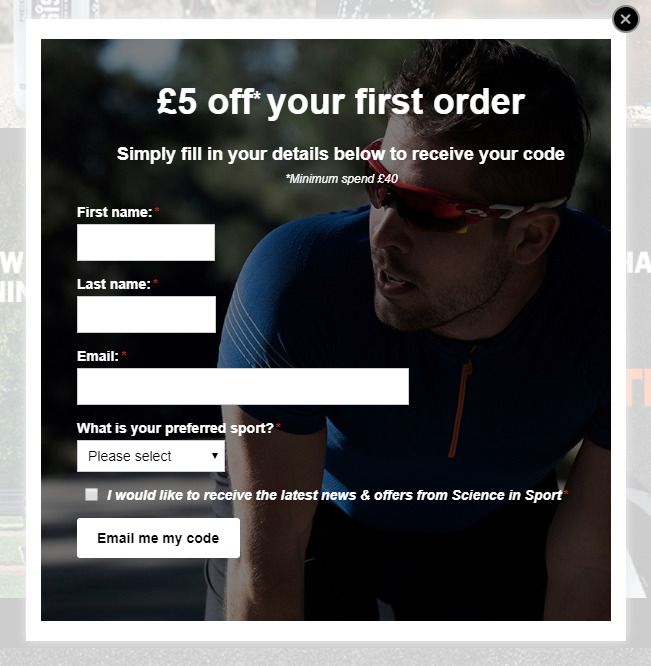
2. Empower subscribers to control their content
Spotify, on the other hand, allows customers to control the content they receive on an account level.
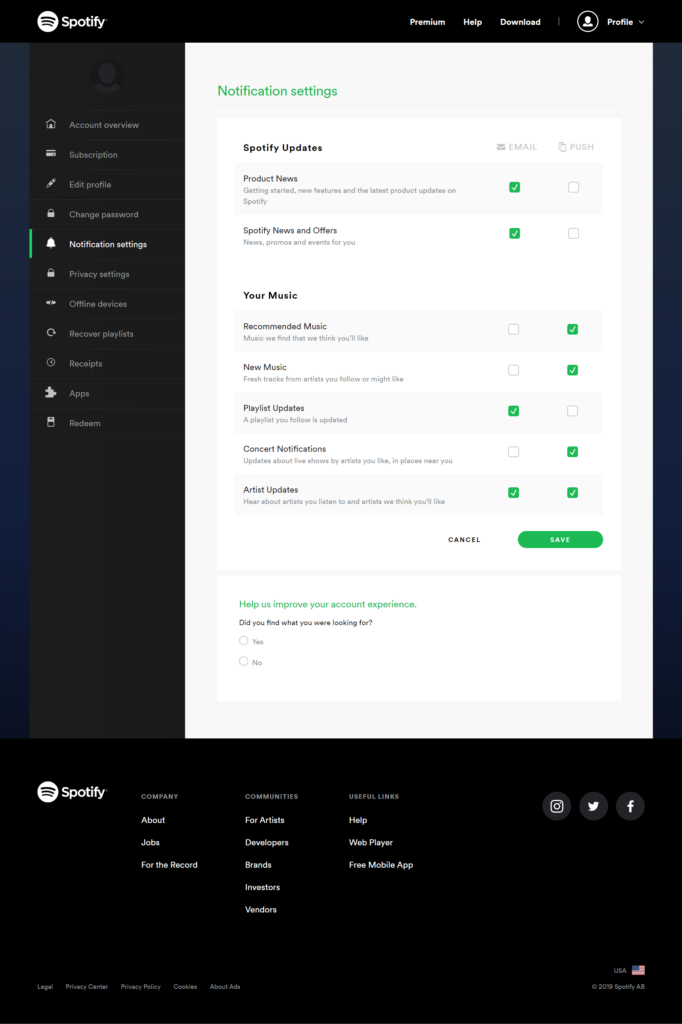
Once an account has successfully been created, customers can choose what they hear about. For each topic, listeners can also choose whether these communications come in the form of an email or a push notification. By diversifying its marketing channels, Spotify is increasing its chances of successfully engaging customers.
3. Enhance personalization in your email preference center
To ensure customers don’t miss their chance to build customer experience, MATCHESFASHION uses its welcome program to push preferences to be submitted.
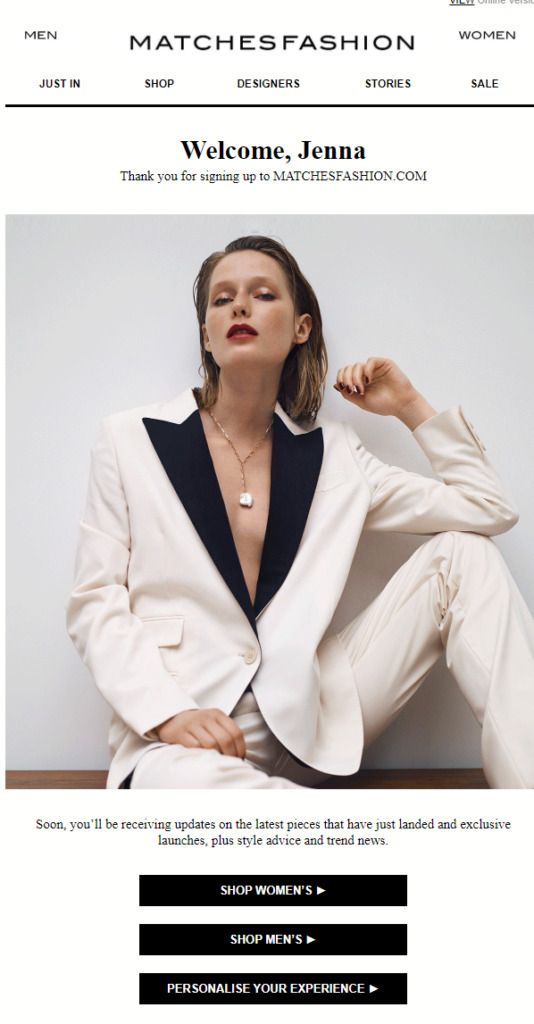
This preference center not only outlines what each newsletter covers but also states the day that it’ll land in customers’ inboxes. This helps build anticipation for the latest announcements and product launches. It also allows shoppers to follow their favorite fashion designers. This information can then be used to deliver personalized edits every Monday and Friday as part of the ‘WOMENSWEAR JUST IN’ subscription.
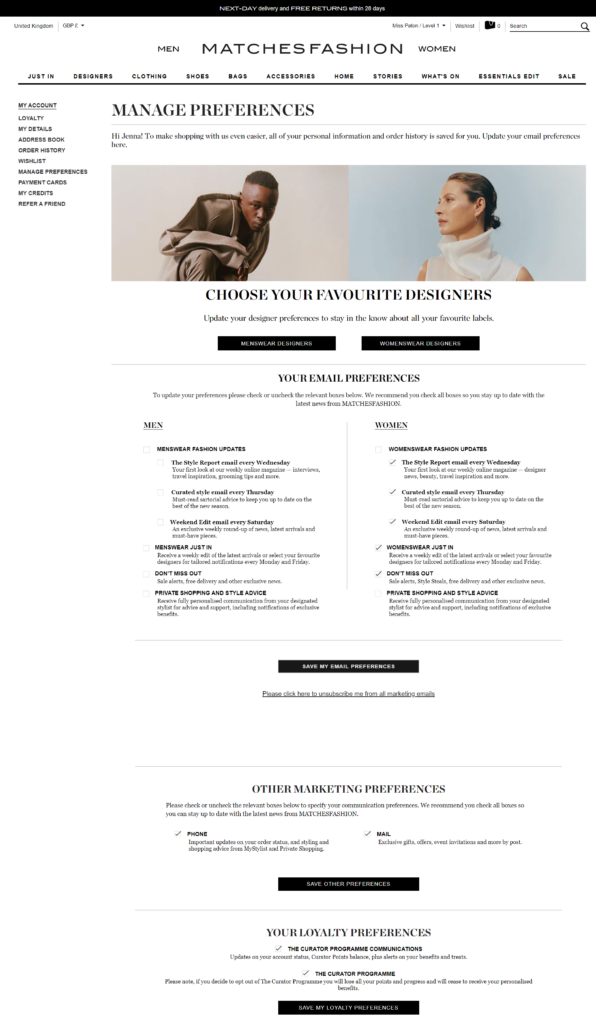
MATCHESFASHION also goes on to confirm whether customers would be interested in receiving marketing via phone and post, as well as membership to its loyalty program.
The overall result: endless opportunities for shoppers to personalize their experience.
4. Retain customers with triggered popovers
Don’t miss a single chance to let customers tell you what they want. J. Crew doesn’t.
When customers click ‘unsubscribe’ in email, J. Crew gives shoppers a final opportunity to tailor its communications. This offers a chance to save the relationship. Customers can either choose to adjust the frequency of their emails or specify the products they would rather hear about.
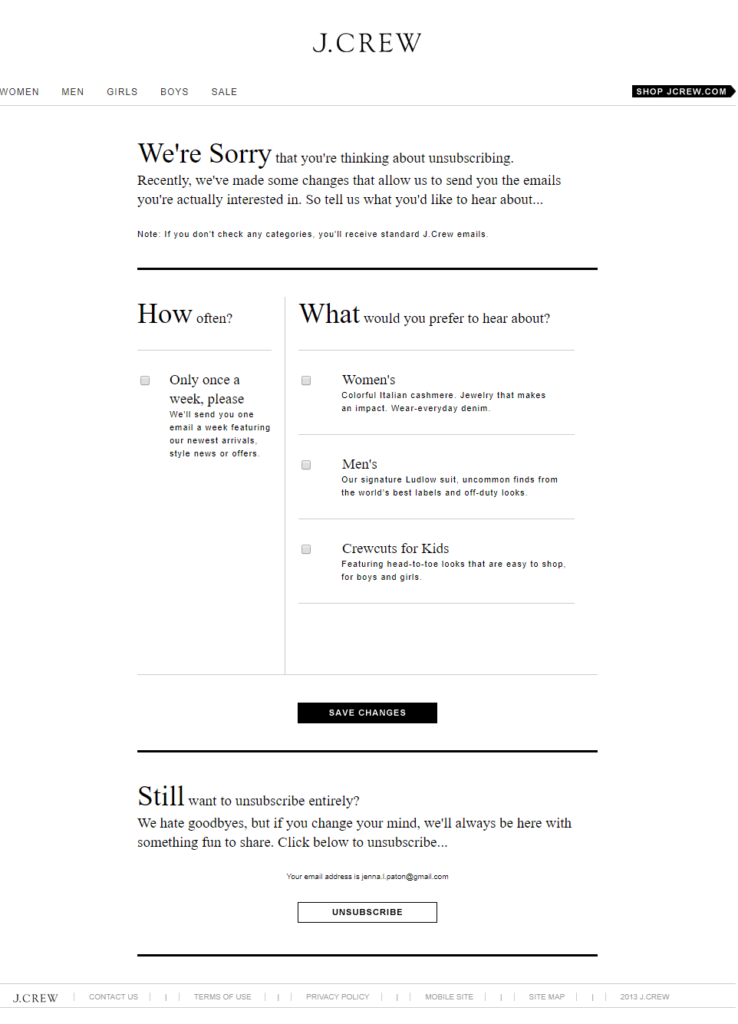
It’s what you do with the data that counts
The secret to successful marketing is all about the quality of the data you have. The better the data you have, the better the experience you can build with your customers. By creating intelligent, personalized journeys for customers and putting the customer first, you’re creating an engaged fanbase, dedicated to your brand.


